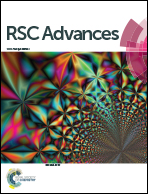Effects of synthetic chalcone derivatives on oxidised palmitoyl arachidonoyl phosphorylcholine-induced proinflammatory chemokines production†
Abstract
Oxidised 1-palmitoyl-2-arachidonoyl-sn-glycero-3-phosphorylcholine (OxPAPC) induces the production of proinflammatory chemokines has been widely studied for its role in vascular inflammation. There is increasing evidence on the role of chalcones as potential anti-inflammatory agents but less is known about its effects on OxPAPC-induced chemokines production and the involvement of unfolded protein response (UPR) signalling, particularly through XBP1 pathway. The present study sought to investigate the inhibitory potential of synthetic chalcone derivatives on the release of interleukin-8 (IL-8) and monocyte chemoattractant protein-1 (MCP-1), induced by OxPAPC through XBP1 signalling pathway on differentiated U-937 macrophages. The effects of synthetic chalcone derivatives on the chemokines productions were investigated using enzyme-linked immunosorbent assays, while the inhibitions of XBP1 signalling were detected using western immunoblot. Results show that all the three tested synthetic chalcone derivatives inhibited OxPAPC-induced chemokines production in a concentration-dependent manner. Compound 1.5 exhibited the strongest inhibition of IL-8 and MCP-1 at 61.4 ± 4.23% and 63.8 ± 2.16%, respectively. Compound 1.5 also achieved the lowest IC50 values for both IL-8 (18.33 ± 1.59 μM) and MCP-1 (13.05 ± 1.37 μM) inhibitions. For XBP1 protein expression, both compound 1.4 and 1.5 exhibited significant concentration-dependent suppression of the protein expressions. The results suggest that synthetic chalcone derivatives may serve as potential alternatives for future development of anti-inflammatory agents, particularly in vascular inflammation.



 Please wait while we load your content...
Please wait while we load your content...